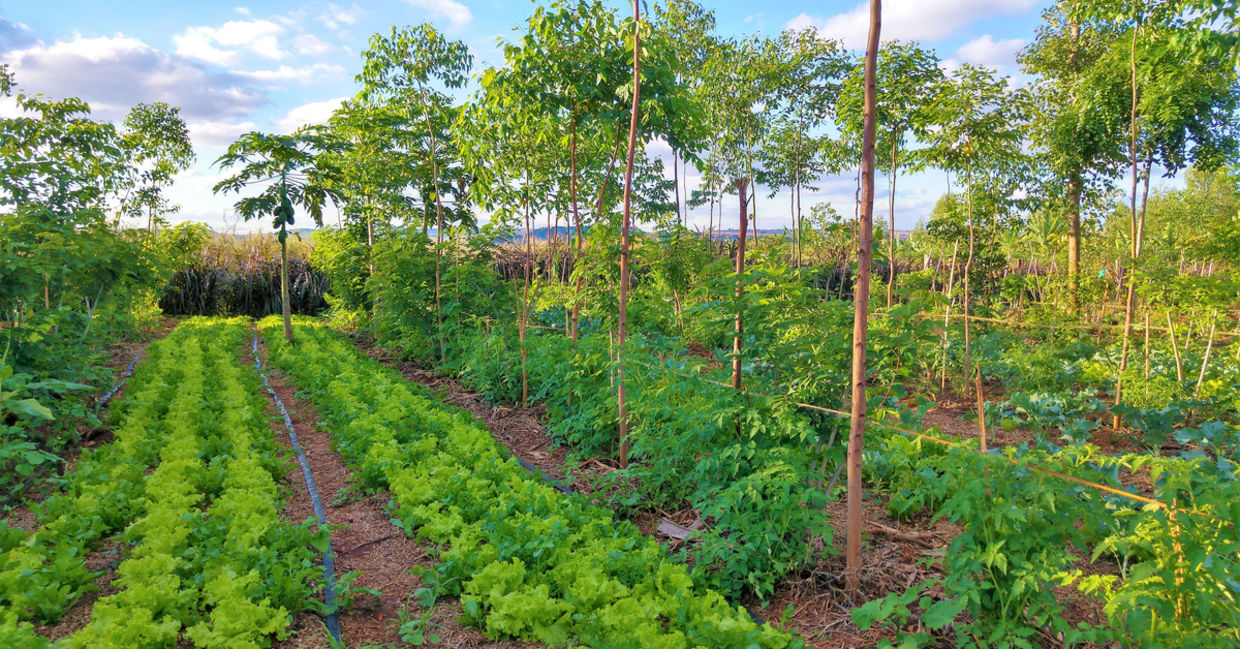
(anacotrin / Shutterstock.com)
Food Crops growing under tree canopies is not a new concept. Foragers take advantage of wild harvesting and in the tropics, home gardens are frequently planted under the trees. Municipalities have used public lands to encourage food forests to give city dwellers access to healthy food. But when it is done on a commercial level with high-value crops, it is called forest farming or agroforestry.
This type of agriculture uses both vertical space and the interaction of the plants and the climate according to the best land management planning. This includes thinning out competing plants in the area you want to farm, planting the seeds or bulbs for the produce you want to grow, soil maintenance and even fencing to keep out pests.
The woodland crops that grow well, according to the US Department of Agriculture are ginseng, goldenseal, shiitake mushrooms, ferns and medicinal herbs.
Most of these farms are located on private land to supplement household income but if there is an available market, it can be done on a much larger scale. Forest farming is often done to provide additional income for farmers who are growing trees commercially for wood or other products. This is a long process and often farmers cannot afford to lose the income from the land while the trees mature.
One example of this is on a small farm along the Connecticut River in Massachusetts. According to the BBC, Jono Neiger planted seven acres of chestnut trees and the trees will not start bearing chestnuts for six years. But that is a long time to wait for income.
That's why Neiger planted smaller trees and bushes under the canopy of the chestnut trees. He is growing elderberries, pawpaws and persimmons which will bear fruit in only two years. He also is raising free range chickens on the land.
This multi-use land view is completely different from modern farming practices that typically grow one crop, damage the soil by tilling, and overuse fertilizers and pesticides.
Neiger's take is that agriculture has to become more sustainable because climate change and soil depletion is threatening the planet's ability to grow enough food.
“Trees fit in well in many places where it’s not suitable to do tillage agriculture. You can use hillsides, where, any time regular monoculture agriculture occurs, it causes a lot of erosion and soil loss. Having trees in these places slows erosion, starts to rebuild soil, and sequesters more carbon,” Neiger told BBC.
He explained that growing while chestnuts may not be commonly eaten today, they are a great source of carbohydrates that could replace grains or corn in people's diets. “It’s basically growing grain on a tree.”
Besides food production, agroforestry can save forests from being cut down for industry or traditional agriculture because there is an economic reason to remain standing.
“Conserving the forest we have is really critical, but someone might be tempted to clear the forest if they feel like they need income from the land. We’re trying to say that there are things you can do to retain that existing forest,” said Steve Gabriel, a mushroom and agroforestry specialist at the Cornell Small Farms program as well as a forest farmer.
“When you’re cutting mushroom logs and making habitats for woodland medicinals, you’re doing good management. You end up with a healthier forest, and you’re often creating a better habitat for wildlife as well,” he added.
In the UK today, farmland and woodland are considered separate categories, and lack the knowledge to combine them according to Helen Chesshire, senior advisor on farming at the Woodland Trust. In fact, half of the hedgerows that were so common on British farms, have been removed for ease of using farm equipment.
Still, there is a need to provide more food while protecting the environment so there is a growing interest in agroforestry she said. “If it’s done right, it will help to avoid those potential trade-offs between food production and other public goods. That’s quite important – to not take land away from food production but to support sustainable food production while delivering other benefits.”
A recent EU study showed that agroforestry covers around 3.3 million hectares across Europe. It is taking hold in the UK and across the pond, there are a growing number of forest farmers in the US.
The process of growing food under the canopy of forests has the potential to boost food security because it will not deplete the soil and uses only sustainable methods.
“With climate change, whether it’s extremely dry or extremely wet, the forest is a very stable ecosystem. The food coming out of there is much less vulnerable than our cropping systems,” Gabriel, told BBC.
“There is a challenge with the potential volume of production we need to feed the population – I don’t think it’s going to replace all the field crops that are grown – but I think it can be a really important way to add to the mix and diversify the foods we have available.”
Sustainable farming methods like forest farming, regenerative agriculture, and indoor vertical farms produce healthier food, healthier soil, and far less greenhouse gas emissions. All of these are necessary for us to feed a growing world population sustainably.
YOU MIGHT ALSO LIKE:
Regenerative Agriculture Can Restore Health to Our Soil
Vertical Farming is a Sustainable Alternative to Conventional Agriculture
5 Ways to Feed a Growing World Population Sustainably







